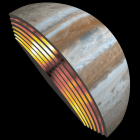Revealing the third dimension of Jupiter’s atmosphere
One year ago, the Juno spacecraft took the chance to look at Jupiter’s deep troposphere down to 200 bars using its microwave radiometer. In this talk, I will introduce the first 3D map of ammonia gas revealed from the inversion of both nadir and limb observations. Ammonia gas is a passive tracer in Jupiter’s atmosphere below the visible cloud. Yet, surprisingly, it has a high concentration near the equator and a low concentration elsewhere down to 50-60 bars, a distance far away from its cloud base. The new observation contradicts the conventional theory of convection on giant planets. Questions arise: “Why wouldn’t convection mix ammonia gas?”, “How does the internal heat get out on a fluid planet?”. In order to solve the puzzle, I developed a cloud-resolving model that directly simulates moist convection on giant planets and its feedback on the atmospheric circulation. The solution to the ammonia puzzle hinges on the water vapor. Though Jupiter is a fluid planet without a surface, condensation of water effectively forms a compositional boundary that decouples the interior from the weather layer. Similar phenomena are expected to happen on ice giants, brown dwarfs and hot Jupiters where the compositional effect is more significant than that on Jupiter.

